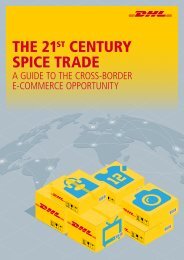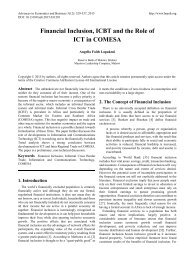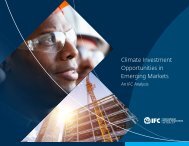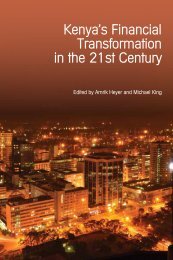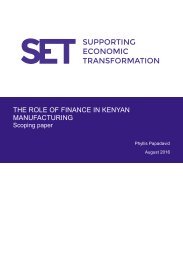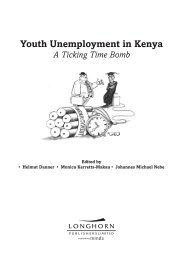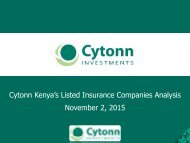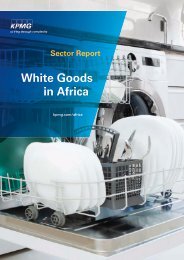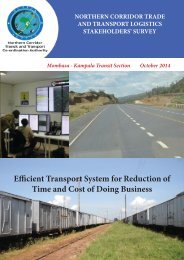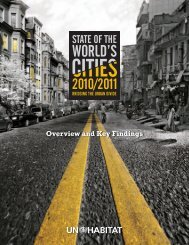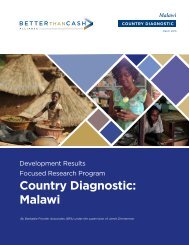FD
gvti301SEaf
gvti301SEaf
You also want an ePaper? Increase the reach of your titles
YUMPU automatically turns print PDFs into web optimized ePapers that Google loves.
for policies to reduce fiscal deficits and debt levels. An assessment<br />
of these specific policies (rather than the broad neoliberal<br />
agenda) reaches three disquieting conclusions:<br />
• The benefits in terms of increased growth seem fairly difficult<br />
to establish when looking at a broad group of countries.<br />
• The costs in terms of increased inequality are prominent.<br />
Such costs epitomize the trade-off between the growth<br />
and equity effects of some aspects of the neoliberal agenda.<br />
• Increased inequality in turn hurts the level and sustainability<br />
of growth. Even if growth is the sole or main purpose<br />
of the neoliberal agenda, advocates of that agenda still need<br />
to pay attention to the distributional effects.<br />
Open and shut?<br />
As Maurice Obstfeld (1998) has noted, “economic theory leaves<br />
no doubt about the potential advantages” of capital account liberalization,<br />
which is also sometimes called financial openness.<br />
It can allow the international capital market to channel world<br />
savings to their most productive uses across the globe. Developing<br />
economies with little capital can borrow to finance investment,<br />
thereby promoting their economic growth<br />
without requiring sharp increases in their own<br />
saving. But Obstfeld also pointed to the “genuine<br />
hazards” of openness to foreign financial flows<br />
and concluded that “this duality of benefits and<br />
risks is inescapable in the real world.”<br />
This indeed turns out to be the case. The<br />
link between financial openness and economic<br />
growth is complex. Some capital inflows, such as<br />
foreign direct investment—which may include<br />
a transfer of technology or human capital—do<br />
seem to boost long-term growth. But the impact<br />
of other flows—such as portfolio investment<br />
and banking and especially hot, or speculative,<br />
debt inflows—seem neither to boost growth nor<br />
allow the country to better share risks with its<br />
trading partners (Dell’Ariccia and others, 2008;<br />
Ostry, Prati, and Spilimbergo, 2009). This suggests<br />
that the growth and risk-sharing benefits<br />
of capital flows depend on which type of flow<br />
is being considered; it may also depend on the<br />
nature of supporting institutions and policies.<br />
Although growth benefits are uncertain, costs<br />
in terms of increased economic volatility and<br />
crisis frequency seem more evident. Since 1980,<br />
there have been about 150 episodes of surges<br />
in capital inflows in more than 50 emerging<br />
market economies; as shown in the left panel<br />
of Chart 2, about 20 percent of the time, these<br />
episodes end in a financial crisis, and many of<br />
these crises are associated with large output<br />
declines (Ghosh, Ostry, and Qureshi, 2016).<br />
The pervasiveness of booms and busts gives<br />
credence to the claim by Harvard economist<br />
Dani Rodrik that these “are hardly a sideshow<br />
or a minor blemish in international capital<br />
flows; they are the main story.” While there are<br />
Ostry, corrected 04/11/20106<br />
Chart 1<br />
many drivers, increased capital account openness consistently<br />
figures as a risk factor in these cycles. In addition to raising the<br />
odds of a crash, financial openness has distributional effects,<br />
appreciably raising inequality (see Furceri and Loungani, 2015,<br />
for a discussion of the channels through which this operates).<br />
Moreover, the effects of openness on inequality are much<br />
higher when a crash ensues (Chart 2, right panel).<br />
The mounting evidence on the high cost-to-benefit ratio of<br />
capital account openness, particularly with respect to shortterm<br />
flows, led the IMF’s former First Deputy Managing<br />
Director, Stanley Fischer, now the vice chair of the U.S.<br />
Federal Reserve Board, to exclaim recently: “What useful<br />
purpose is served by short-term international capital flows?”<br />
Among policymakers today, there is increased acceptance<br />
of controls to limit short-term debt flows that are viewed as<br />
likely to lead to—or compound—a financial crisis. While not<br />
the only tool available—exchange rate and financial policies<br />
can also help—capital controls are a viable, and sometimes the<br />
only, option when the source of an unsustainable credit boom<br />
is direct borrowing from abroad (Ostry and others, 2012).<br />
Push to compete<br />
Since the 1980s countries have adopted policies to foster increased domestic<br />
competition through deregulation and opening their economies to foreign capital.<br />
(index of competition)<br />
1.0<br />
0.8<br />
United States<br />
0.6<br />
0.6<br />
0.4<br />
Chile<br />
World<br />
0.4<br />
Brazil<br />
Ostry, revised 05/5/2016<br />
0.2<br />
0.2<br />
India<br />
0.0<br />
1962 72 82 92<br />
0.0<br />
2002 1962 72 82 92 2002<br />
Source: Ostry, Prati, and Spilimbergo (2009).<br />
Note: The chart shows the average values of a composite index of structural policies that countries adopted with the aim of<br />
increasing competition. The areas are openness of capital account; openness of current account; liberalization of agricultural<br />
and network industries; domestic financial liberalization; and reduction in the amount of taxes between wages and take-home<br />
pay. An index value of zero is total lack of competition and 1 is unfettered competition.<br />
Chart 2<br />
1.0<br />
0.8<br />
Spain<br />
Opening up to trouble<br />
Surges of foreign capital inflows increased the chance of a financial crisis, and<br />
such inflows worsen inequality in a crisis.<br />
(increased probability of crisis)<br />
20<br />
16<br />
Full sample<br />
Postsurge period<br />
12<br />
8<br />
4<br />
0<br />
Financial crisis (banking<br />
or currency crisis)<br />
Twin crises (banking<br />
and currency crisis)<br />
(increase in inequality, percent)<br />
4<br />
No crisis<br />
Crisis<br />
3<br />
Year 2 Year 5<br />
Sources: Ghosh, Ostry, and Qureshi (2016), left panel; Furceri and Loungani (2015), right panel.<br />
Note: The left panel shows the increased probability of a crisis during a surge in capital inflows. It is based on 165 episodes<br />
of inflows in 53 emerging market economies between 1980 and 2014. The right panel compares the increase in the Gini<br />
measure of income inequality when capital account liberalization was followed by a crisis with periods when no crisis ensued.<br />
It is based on 224 episodes of capital account liberalization in 149 countries between 1970 and 2010.<br />
2<br />
1<br />
0<br />
Finance & Development June 2016 39



